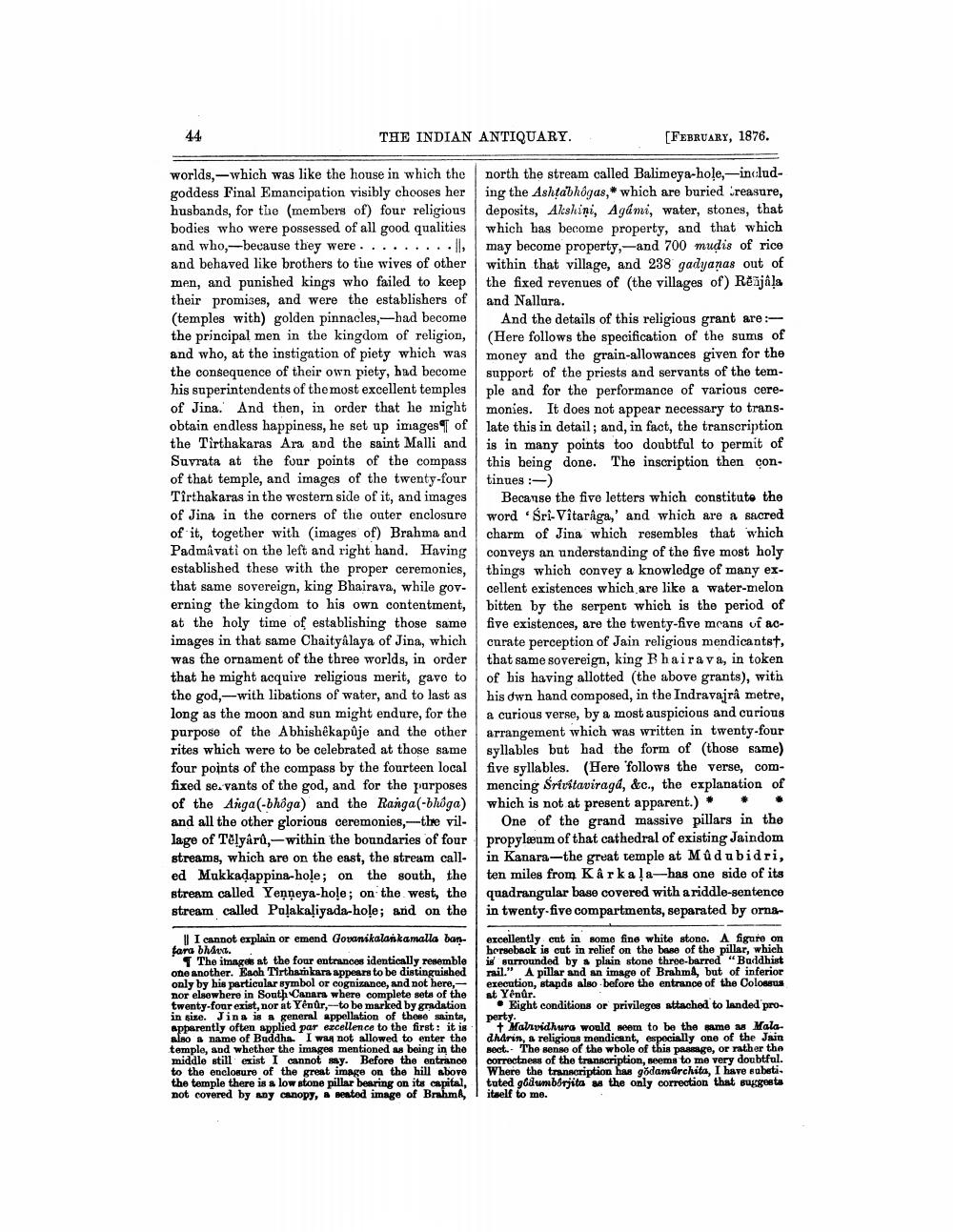________________
44
THE INDIAN ANTIQUARY.
[FEBRUARY, 1876.
worlds, which was like the house in which the north the stream called Balimeya-hole-includgoddess Final Emancipation visibly chooses her ing the Ashtabhôgas, which are buried Creasure, husbands, for the members of) four religious deposits, Akshini, Agámi, water, stones, that bodies who were possessed of all good qualities which has become property, and that which and who,- because they were .........ll, may become property,--and 700 mudis of rice and behaved like brothers to the wives of other within that village, and 238 gadyanas out of men, and punished kings who failed to keep the fixed revenues of the villages of) Reijala their promises, and were the establishers of and Nallara. (temples with) golden pinnacles,-had become And the details of this religious grant are:the principal men in the kingdom of religion, (Here follows the specification of the sums of and who, at the instigation of piety which was
money and the grain-allowances given for the the consequence of their own piety, had become support of the priests and servants of the temhis superintendents of the most excellent temples ple and for the performance of various cereof Jina. And then, in order that he might monies. It does not appear necessary to transobtain endless happiness, he set up images of late this in detail; and, in fact, the transcription the Tirthakaras Ara and the saint Malli and is in many points too doubtful to permit of Suvrata at the four points of the compass this being done. The inscription then conof that temple, and images of the twenty-four Tirthakaras in the western side of it, and images Because the five letters which constitute the of Jina in the corners of the outer enclosure word Sri-Vitaraga,' and which are a sacred of it, together with images of) Brahma and charm of Jina which resembles that which Padmavati on the left and right hand. Having conveys an understanding of the five most holy established these with the proper ceremonies, things which convey a knowledge of many exthat same sovereign, king Bhairava, while gov- cellent existences which are like a water-melon erning the kingdom to his own contentment, bitten by the serpent which is the period of at the holy time of establishing those same five existences, are the twenty-five means of acimages in that same Chaityalaya of Jina, which curate perception of Jain religious mendicantst, was the ornament of the three worlds, in order that same sovereign, king Bhairava, in token that he might acquire religious merit, gave to of bis having allotted (the above grants), with the god, with libations of water, and to last as his own hand composed, in the Indravajra metre, long as the moon and sun might endure, for the a curious verse, by a most auspicious and curious purpose of the Abhishekapůje and the other arrangement which was written in twenty-four rites which were to be celebrated at those same syllables but had the form of (those same) four points of the compass by the fourteen local five syllables. (Here follows the verse, comfixed se, vants of the god, and for the purposes mencing Srivitaviragd, &c., the explanation of of the Anga (-bhôga) and the Ranga(-bhôga) which is not at present apparent.) * * * and all the other glorious ceremonies,--the vil- One of the grand massive pillars in the lage of Télyárů, --within the boundaries of four propylæum of that cathedral of existing Jaindom streams, which are on the east, the stream call- in Kanara--the great temple at Müd ubidri, ed Mukkadappina-hole; on the south, the ten miles from Karkala-has one side of its stream called Yeņneya-hole; on the west, the quadrangular base covered with a riddle-sentence stream called Polakaliyada-hole; and on the in twenty-five compartments, separated by orna
|| I cannot explain or emend Govanskalankamalla bantara bhat.
The images at the four entrances identically resemble ono another. Each Tirthamkara appears to be distinguished only by his particular symbol or cognizance, and not here, - nor elsewhere in South Canara where complete sets of the twenty-four exist, nor at Yênür,--to be marked by gradation in size.Jina is a general appellation of these sainta,
280 sainta, apparently often applied par excellence to the first: it is RAO & name of Buddha. I way not allowed to enter the temple, and whether the images mentioned as being in the middle still exist I cannot esy. Before the entrance to the enclosure of the great image on the hill above the temple there is a low stone pillar bearing on its capital, not covered by any canopy, a seated image of BrahmA
excellently cut in some fine white stono. A figare on horseback is cut in relief on the base of the pillar, which is surrounded by a plain stone three-barred "Buddhist rail." A pillar and an image of BrahmA, but of inferior execution, stapds also before the entrance of the Colossus at Yênür.
Eight conditions or privileges attached to landed property.
+ Malvidhura would seem to be the same as Maladharin, & religious mendicant, especially one of the Jain sect. The sense of the whole of this passage, or rather the correctness of the transcription, seems to me very doubtful. Where the transcription has godamirchita, I have substituted godwmborjita as the only correction that suggesta itself to me.




